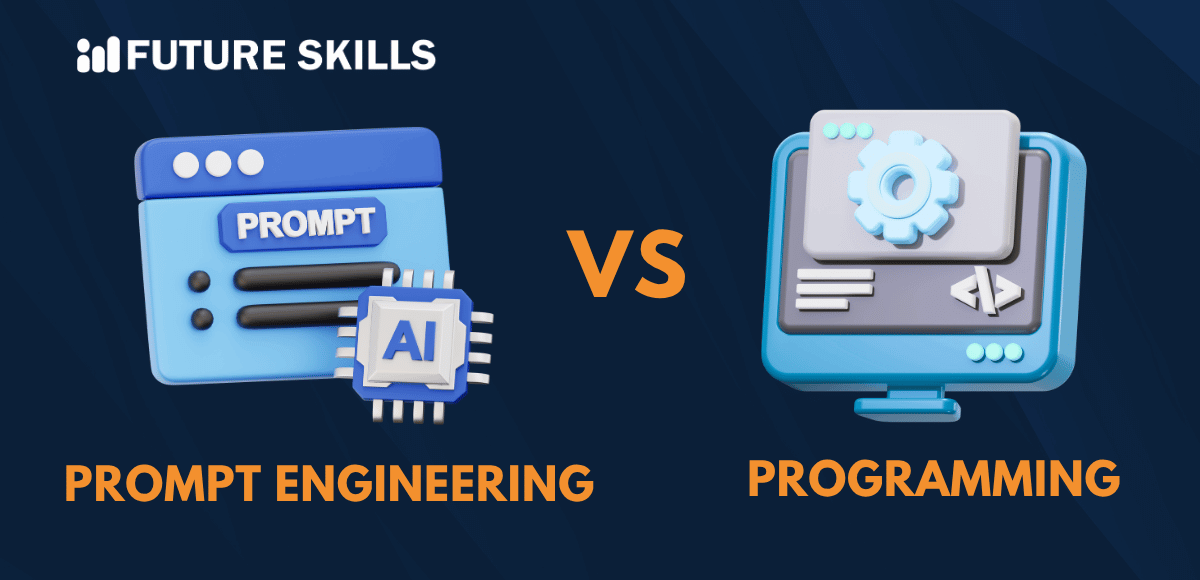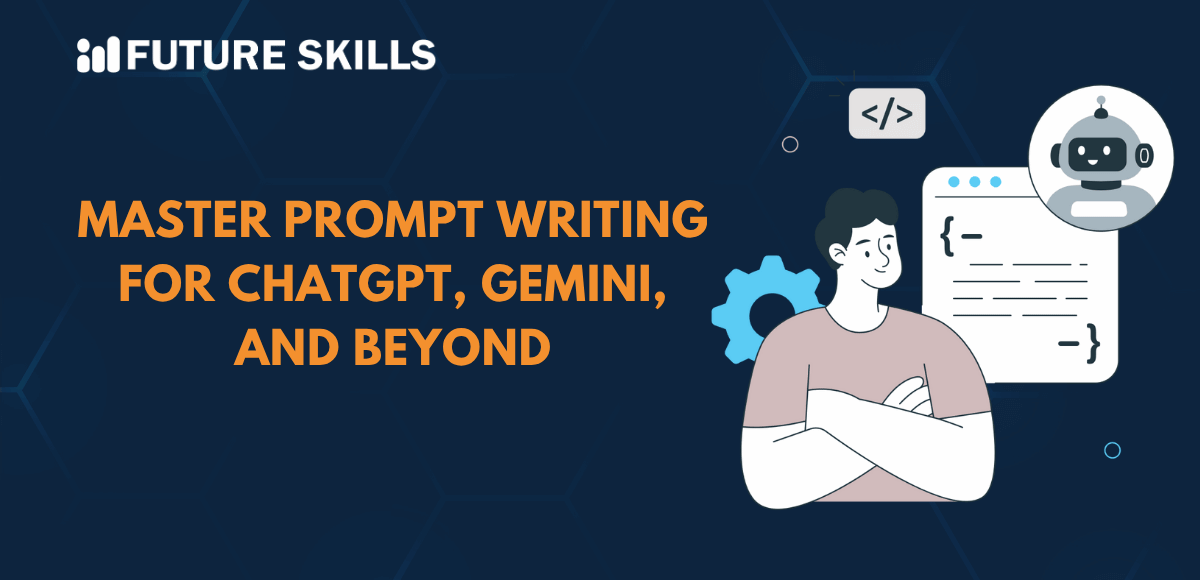Large Language Models, or LLMs, have emerged as groundbreaking tools with the capabilities required to transform our interactions with AI. A few years ago, no one would have believed that you could use AI technologies without advanced technical expertise. Interestingly, you can rely on LLMs to make the most of AI tools for tasks such as question answering and generating human-like text with impressive accuracy.
The top prompting techniques to create effective prompts play a major role in ensuring effectiveness of LLM interactions. Prompting techniques help in guiding the outputs of AI models with more coherent and relevant responses. With the help of prompting techniques, you can obtain desired information, guide conversations, and maintain context in your interactions with AI systems. Learn more about the most popular prompting techniques that you can use to your advantage.
Become a job-ready certified prompt engineer with Prompt Engineering Certification. This course is tailored for every individual who is keen to learn prompt engineering from scratch to an advanced level.
What is the Significance of Prompt Engineering?
Technology has been evolving at a rapid pace in recent times, especially with the scope for innovation in AI systems. As a matter of fact, AI has reached the stage where LLMs can learn, think, and interact like humans. However, the importance of LLM prompting techniques has also become clearly evident to LLM users.
Without prompting techniques, LLMs are likely to fail at providing effective responses. People who use AI and machine learning technologies have pointed out that they have achieved better productivity and simpler avenues to complete their work. On the other hand, some people also believe that the capabilities and effectiveness of AI models are generally exaggerated.
Why do people reject AI despite its impressive capabilities for generating responses to user queries in natural language? You can find the answer to such questions in the failure of AI systems to understand user queries. For example, AI chatbots such as ChatGPT come up with generic responses when they cannot understand the prompt.
Therefore, prompt engineering techniques help establish the difference between obtaining helpful information from AI and obtaining irrelevant responses. Prompt engineering has become a significant discipline in the AI landscape as the popularity of LLMs continues to grow exponentially.
We offer a free ChatGPT and AI Fundamentals Course for everyone to learn how ChatGPT and AI work. Learn the basics and use cases of ChatGPT as well as how to write prompts effectively.
What Do You Have to Do in Prompt Engineering?
The significance of prompt engineering in enhancing the usability and effectiveness of LLMs and AI systems proves that it is a crucial requirement for the growth of AI. You may think that it must be a complex technical procedure as it deals with ‘engineering’ prompts. Interestingly, the best prompting techniques don’t come with a steep learning curve once you learn what prompt engineering entails.
Prompt engineering is the blend of art and science for the process of creating instructions that you would feed to AI language models. The primary goal of prompt engineering revolves around obtaining the desired response from AI models. It helps simplify and improve communication between AI models and humans.
Almost everyone in the AI landscape must have come across news articles on new and advanced prompting techniques that can help generate accurate and relevant responses. The impact of prompt engineering on usability of AI models draws attention to their role in unlocking the full potential of AI. If you feel that your prompts have not been successful in achieving the desired tasks, then you must learn prompting techniques right away.
What are the Top Prompting Techniques for Generative AI?
Effective prompts are the most essential requirement to make the best use of large language models that run generative AI systems. The top prompting techniques can help you create prompts that guide generative AI outputs and establish clear constraints. You can use prompt engineering to provide a clear impression of context and the instructions for generative AI systems. As a result, users can tailor the behavior of the model to their interests and achieve accurate and relevant responses. Here is an outline of the five most popular prompting techniques that you should use for generative AI.
Zero-Shot Prompting
The foremost addition among prompting techniques for generative AI would draw attention toward zero-shot prompting. It is one of the basic prompt engineering techniques that help you use pre-trained language models to complete tasks for which it was never trained. The model utilizes its general understanding of natural language alongside the patterns learned in the training process to generate relevant outputs. How can you achieve tasks with a model that has never learned how to do them? Zero-shot prompting involves creating a prompt that provides clear instructions for the task that you want to achieve.
Zero-shot prompting does not involve any additional programming. For example, you can ask a generative AI tool to translate a specific phrase from English to Spanish. The generative AI tool may not have been trained for translation tasks. On the other hand, it can effectively understand the semantics and structure of natural language. The prompt would elicit a reasonable response in the form of translation to Spanish by relying on its understanding of natural language.
Chain of Thought Prompting
The next prominent addition among prompting techniques for generative AI is Chain of Thought or CoT prompting. It is one of the most popular advanced prompting techniques that can help you obtain contextually relevant and intricate responses. The technique involves guiding the model through a systematic process in which the generative AI model thinks at each step of the process to generate the desired responses. Chain of Thought prompting involves exploring ideas, new concepts, and problem-solving methods. The prompting technique was introduced in 2022 and works by using intermediate reasoning steps to empower generative AI models with complex reasoning features.
You should also keep an eye on automatic chain of thought prompting. It is one of the best prompting techniques for generative AI when you apply a chain of thought prompting with different examples. An automatic chain of thought prompting removes manual efforts by using LLMs with step-by-step thinking prompts to create reasoning chains, for example. In addition, an automatic chain of thought prompting also involves sampling questions with diversity alongside generating reasoning chains.
Tree of Thought Prompting
The term ‘Tree of Thought’ might lead you to assume that it is similar to chain of thought prompting. However, it is one of the popular LLM prompting techniques that leverage a tree structure in which every thought helps you move closer to solving a problem. The language model would navigate through the different intermediate thoughts to develop a deliberate reasoning pathway.
Tree of Thought prompting helps generate and explore multiple thought paths through a combination of model capabilities with search algorithms. You have to specify a particular number of candidate thoughts to enable exploration alongside the number of steps.
Prompt Chaining
The most crucial entry in a list of the top prompting techniques for generative AI is prompt chaining. You must note that reliability is the biggest problem with AI systems. Prompt chaining can help in addressing the problem of reliability by breaking down complex tasks into smaller tasks. The LLM receives a prompt for the smaller tasks, and the output is leveraged as input for the next prompt in the chain.
Prompt chaining is useful in cases where LLMs struggle with highly complex prompts for complicated tasks. Chaining prompts can ensure that each prompt achieves incremental transformations that lead toward the desired output. Prompt chaining also helps in improving transparency of generative AI applications alongside improving reliability and control. It ensures that you can perform better by debugging the problems in model responses. The best use of prompt chaining is visible in scenarios where you have to develop LLM-based conversational assistants.
Generated Knowledge Prompting
Another notable choice among prompt engineering techniques is generated knowledge prompting, which can help obtain more informative responses from generative AI models. Before you ask generative AI to solve a specific problem, you must ask the model to generate background information for the task. You can choose two different approaches for generating knowledge-prompting techniques. First of all, you can use the single prompt approach, which only requires one prompt to achieve the task.
Another approach for generated knowledge prompting is the use of dual prompts. The dual prompt approach involves feeding output from the first prompt to the next prompt to achieve the desired task. For example, you can create a blog post on generative AI by using the first prompt to ask the system. The first prompt can ask for background information about generative AI. With the availability of background information on generative AI, the system could create a better blog. As a result, you can generate a blog with contextually relevant insights about generative AI.
Our Certified AI Professional (CAIP)™ Course offers deep knowledge of how AI works. This AI certification program can help you learn all the concepts and use cases of AI from highly qualified instructors.
Final Words
The review of the popular prompting techniques shows that you can tailor generative AI to work according to your interests. The best prompting techniques for generative AI can help you optimize the systems to achieve desired goals. You can also find many other prompting techniques that use distinct approaches to accomplish the assigned tasks.
It is important to note that you can try different prompting techniques as experiments to figure out the best option for specific types of tasks. For example, a chain of thought prompting and prompt chaining are recommended for tasks that require complex reasoning abilities. Discover more insights on other prompting techniques and find out how they serve generative AI right now.






